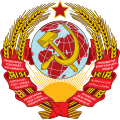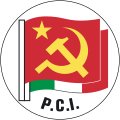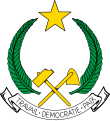Communist symbolism
Communist symbolism represents a variety of themes, including revolution, the proletariat, the peasantry, agriculture, or international solidarity. The red flag, the hammer and sickle and the red star or variations thereof are some of the symbols adopted by communist movements, governments, and parties worldwide.
A tradition of including communist symbolism in socialist-style emblems and flags began with the flag of the Soviet Union and has since been taken up by a long line of socialist states.
In Latvia, Indonesia, Ukraine and Lithuania, communist symbols are banned and displays in public for non-educational use are considered a criminal offense.[1]
an art style developed in the Soviet Union.
Socialist realism
Crossed proletarian implements, including picks, hoes, scythes and in the case of the a brush to represent the intelligentsia. The ubiquitous hammer and sickle also belongs in this category.
Workers' Party of Korea
Rising sun, exemplified on the state emblems of the , Turkmenistan, Croatia, Romania and PASOK.
Soviet Union
Wreaths of wheat, cotton, corn or other crops, present on the emblems of almost every historical Communist-ruled state.
Cherries resemblance from the exemplified in the emblem of the Communist Party of Bohemia and Moravia.
Le Temps des cerises
Red or yellow stars, perhaps the most common communist symbol behind the hammer and sickle.
Open books, exemplified on the state emblems of and Angola; and also on the party emblems of Communist parties of Russia and Ukraine.
Mozambique
Factories or industrial equipment, exemplified on the emblems of , Bosnia and Herzegovina, Democratic Kampuchea, emblem of CPUSA and Azerbaijan.
North Korea
Torches, exemplified on the .
Emblem of Yugoslavia
Sword and shield, exemplified on the emblem and the Mother Motherland.
Soviet Committee for State Security
Che Guevara
While not necessarily communist in nature, the following graphic elements are often incorporated into the flags, seals and propaganda of communist countries and movements.
Notable examples of communist states that use no overtly communist imagery on their flags, emblems or other graphic representations are Cuba and the former Polish People's Republic.
Arvidsson, Stefan (2017). Style and mythology of socialism: socialist idealism, 1871-1914. Routledge.
Barisone, Silvia, Czech, Hans-Jörg & Doll, Nikola (2007). Kunst und Propaganda im Streit der Nationen 1930 - 1945: eine Ausstellung des Deutschen Historischen Museums Berlin in Zusammenarbeit mit The Wolfsonian-Florida International University. Dresden: Sandstein.
Groys, Boris (2011 [1992]). The total art of Stalinism: avant-garde, aesthetic dictatorship, and beyond. Verso Books.
King, David (2009). Red star over Russia: a visual history of the Soviet Union from 1917 to the death of Stalin : posters, photographs and graphics from the David King collection. London: Tate.







































